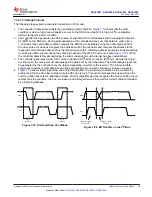
7.4.4 Fault-Dump Mode
The DACx300x provides a feature to save a few registers into the NVM when the FAULT-DUMP bit is triggered
or when the GPIO mapped to fault-dump is triggered (see also
). This feature is useful in system-level
fault management to capture the state of the device or system just before a fault is triggered, and to allow
diagnosis after the fault has occurred. The registers saved when fault-dump is triggered, are:
• CMP-STATUS[7:0]
• DAC-0-DATA[15:8]
• DAC-1-DATA[15:8]
Note
When the fault-dump cycle is in progress, any change in the data can corrupt the final outcome. Make
sure the comparator and the DAC codes are stable during the NVM write cycle.
shows the storage format of the registers in the NVM.
Table 7-3. Fault-Dump NVM Storage Format
NVM ROWS
B31-B24
B23-B16
B15-B8
B7-B0
Row1
CMP-STATUS[7:0]
Don't care
Row2
DAC-1-DATA[15:8]
Don't care
DAC-1-DATA[15:8]
The data captured in the NVM after the fault dump can be read in a specific sequence:
1. Set the EE-READ-ADDR bit to 0b in the COMMON-CONFIG register, to select row1 of the NVM.
2. Trigger the read of the selected NVM row by writing 1 to the READ-ONE-TRIG in the COMMON-TRIGGER
register; this bit autoresets. This action copies that data from the selected NVM row to SRAM addresses
0x9D (LSB 16 bits from the NVM) and 0x9E (MSB 16 bits from the NVM).
3. To read the SRAM data:
a. Write 0x009D to the SRAM-CONFIG register.
b. Read the data from the SRAM-DATA register to get the LSB 16 bits.
c. Write 0x009E to the SRAM-CONFIG register.
d. Read the data from the SRAM-DATA register again to get the MSB bits.
4. Set the EE-READ-ADDR bit to 1b in the COMMON-CONFIG register, to select row2 of the NVM. Repeat
steps 2 and 3.
DAC53001, DAC53002, DAC63001, DAC63002
SLASF48 – MAY 2022
Copyright © 2022 Texas Instruments Incorporated
35
Product Folder Links:
















































